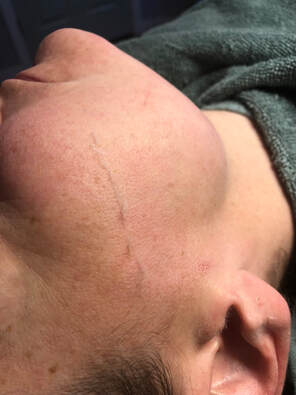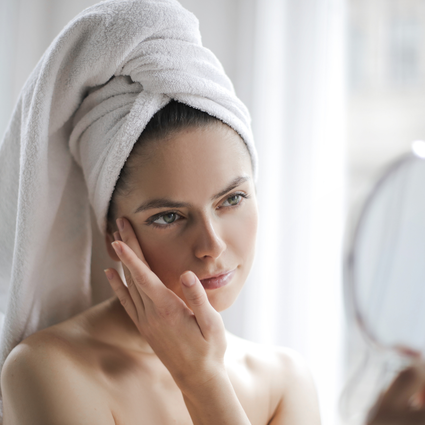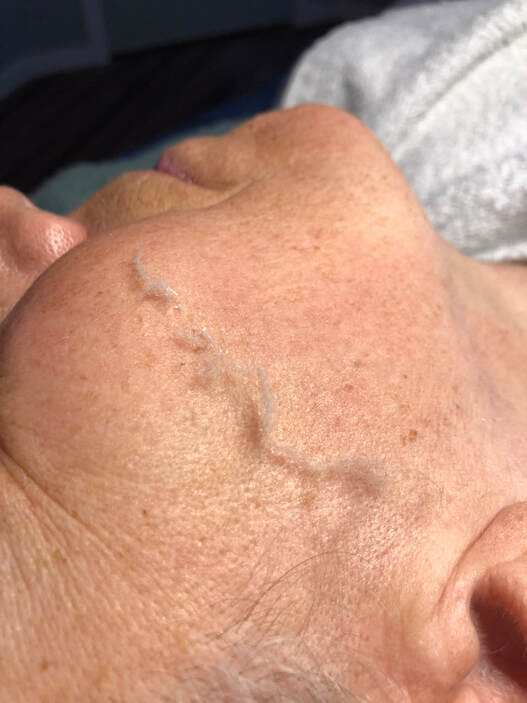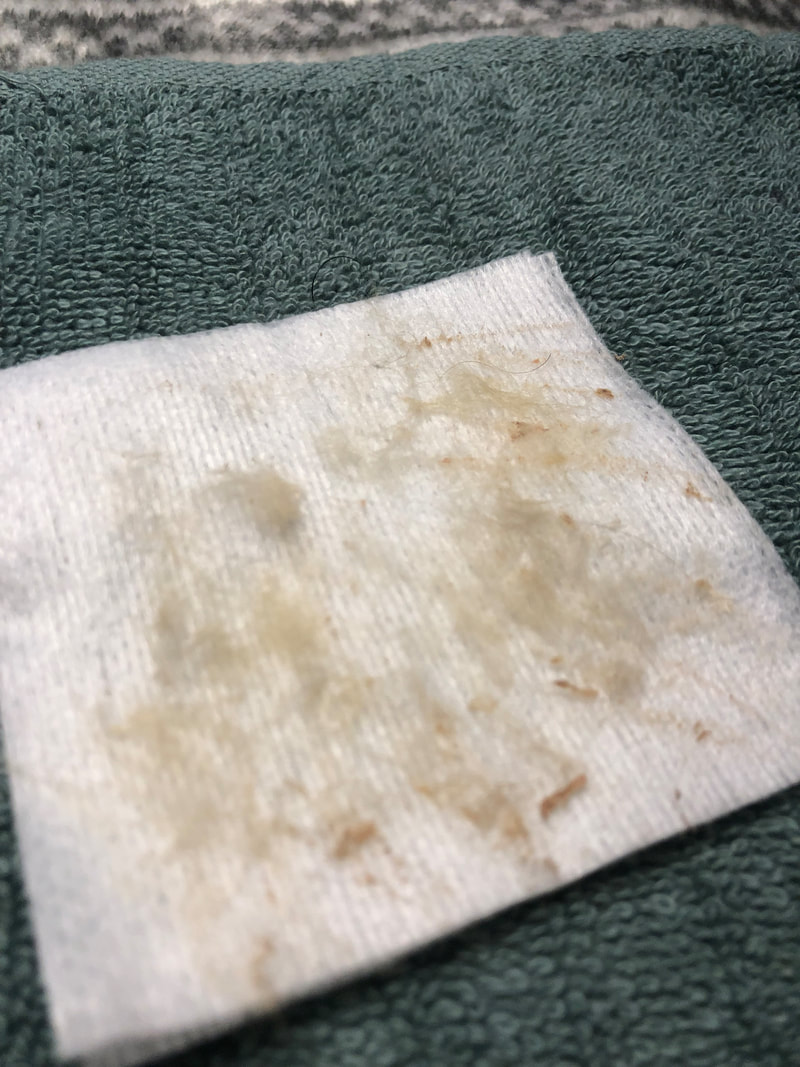Dermaplaning is a skin rejuvenation treatment that removes the top layer of skin, exfoliating it, and at the same time removing dirt and temporarily removing peach fuzz!

Sometimes, dead skin cells remain on the surface longer than they should, clogging pores and hair follicles and creating rough patches. This can not only cause pimples but also block your skincare products from penetrating the skin, which is why exfoliation is essential for maintaining an even, healthy glow. Dermaplaning is a cosmetic procedure that removes the top layer of your skin, exfoliating it while at the same time getting rid of dirt and excess oils, and temporarily removing peach fuzz, aka vellus hair. The procedure will leave your skin brighter, smoother, better able to absorb product, plus dermaplaning helps makeup application look more even and flawless.
It's important to note that dermaplaning is an exfoliation and skin-rejuvenation procedure, not a hair removal procedure, however the vellus hair (peach fuzz) is removed at the same time. Dermaplaning uses a scalpel blade which is different to using a razor to remove hair. Dermaplaning works best on clients with fair skin and light hair. If you have coarse, dark facial hair, or facial hair caused by hormonal imbalance, then waxing, laser or electrolysis would be recommended as a hair removal treatment.
Overtime, dermaplaning can:
In addition to offering incredible benefits for patients as a standalone treatment, dermaplaning is an excellent pre-treatment for other services because the procedure removes dirt, oils, dead skin cells and other barriers, allowing other treatments to penetrate deeper into the skin. One of the top services to combine with dermaplaning is a hydrating facial, or a chemical peel. Removing dead cells and peach fuzz via dermaplaning then allows for deeper penetration and more effective use of the chemical peel.
It's important to note that dermaplaning is an exfoliation and skin-rejuvenation procedure, not a hair removal procedure, however the vellus hair (peach fuzz) is removed at the same time. Dermaplaning uses a scalpel blade which is different to using a razor to remove hair. Dermaplaning works best on clients with fair skin and light hair. If you have coarse, dark facial hair, or facial hair caused by hormonal imbalance, then waxing, laser or electrolysis would be recommended as a hair removal treatment.
Overtime, dermaplaning can:
- soften fine lines and wrinkles
- reduce skin hyperpigmentation
- minimize deep acne scarring
- stimulate collagen and elastin production
- even out skin texture
- help with hyperkeratosis (a thickening of the outer layer of skin).
- help reduce milia bumps
- correct congestion, that causes acne.
In addition to offering incredible benefits for patients as a standalone treatment, dermaplaning is an excellent pre-treatment for other services because the procedure removes dirt, oils, dead skin cells and other barriers, allowing other treatments to penetrate deeper into the skin. One of the top services to combine with dermaplaning is a hydrating facial, or a chemical peel. Removing dead cells and peach fuzz via dermaplaning then allows for deeper penetration and more effective use of the chemical peel.
|
Risks and side effects of dermaplaning
Most people have little to no irritation or reaction. Short-term side effects may include:
|
When should you NOT dermaplane?
There are circumstances when dermaplaning is not suitable:
There are circumstances when dermaplaning is not suitable:
- If you have a current acne breakout. A few pimples are not a problem as they can be worked around, however if large areas of your face are experiencing a breakout it is best to wait until your skin has improved before dermaplaning.
- If you have extremely sensitive skin.
- If you have milia bumps covering a large portion of your face. A milium cyst is small, white bump that typically appears on the nose, cheeks and under the eyes.
- If you have inflammatory skin conditions like rosacea or eczema.
- Those with thinning skin that’s prone to cuts and tear.
Dermaplaning Myths
Myth #1: Dermaplaning is painful
On the contrary! Dermaplaning is actually one of the least painful ways to exfoliate the skin and remove dead skin cells. Many people describe the feeling of dermaplaning as a gentle tickle or brushing sensation.
Myth #2: Your peach fuzz will grow back thicker & darker
Many people believe hair that has been shaved grows back thicker and darker, however this is simply not true. You can’t change the structure of your hair follicle by simply shaving your hair off. Dermaplaning involves removing very fine hair called vellus hair and removing it with a dermaplaning tool will have little to no impact on how it looks when it grows back. Once removed the hair will grow back in about a week. At worst, you’ll likely feel some “stubble”, but it’s typically not noticeable to anyone but you.
Myth #3: Dermaplaning is the same as shaving your face with a razor
Shaving your face with a razor is not going to give you the same results as a medical-grade scalpel and highly-trained hand. Dermaplaning by a trained esthetician uses a surgical #10 scalpel which also gets rid of a superficial layer of dead skin. When using a shaving device, you’re just removing hair. It is always best to have any type of medical skin rejuvenation performed by a licensed professional with experience!
Myth #1: Dermaplaning is painful
On the contrary! Dermaplaning is actually one of the least painful ways to exfoliate the skin and remove dead skin cells. Many people describe the feeling of dermaplaning as a gentle tickle or brushing sensation.
Myth #2: Your peach fuzz will grow back thicker & darker
Many people believe hair that has been shaved grows back thicker and darker, however this is simply not true. You can’t change the structure of your hair follicle by simply shaving your hair off. Dermaplaning involves removing very fine hair called vellus hair and removing it with a dermaplaning tool will have little to no impact on how it looks when it grows back. Once removed the hair will grow back in about a week. At worst, you’ll likely feel some “stubble”, but it’s typically not noticeable to anyone but you.
Myth #3: Dermaplaning is the same as shaving your face with a razor
Shaving your face with a razor is not going to give you the same results as a medical-grade scalpel and highly-trained hand. Dermaplaning by a trained esthetician uses a surgical #10 scalpel which also gets rid of a superficial layer of dead skin. When using a shaving device, you’re just removing hair. It is always best to have any type of medical skin rejuvenation performed by a licensed professional with experience!


